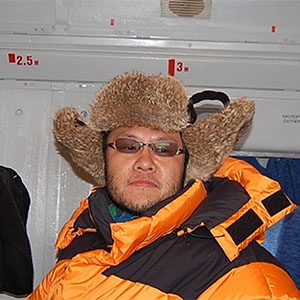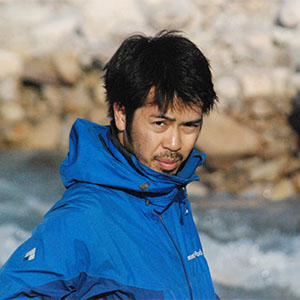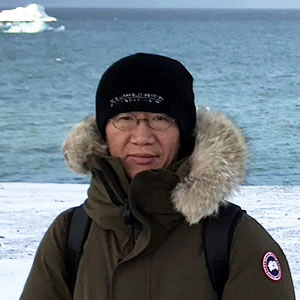Press release with author’s message
— From ArCS II News Letter No.1 —
ArCS II News Letter No.1 had an article “Frontiers of Arctic Research” that brings investigators’ comments on their research projects. Feel the passion of investigators in these comments telling their thoughts, future prospect, and backstories of their research projects.
*Affiliations are at the time of the newsletter publication.
The origin of cold temperature in the Arctic Ocean was in Siberian climates!

Yusuke Kawaguchi
(Research Associate at Atmosphere and Ocean Research Institute, The University of Tokyo)
The research project has led to the discovery of the fact that the narrow channel (Anadyr Strait) between Alaska and Siberia may control the amount of heat in seawater flowing into the Arctic Ocean. The study was accomplished by using two vessels, Japan’s “MIRAI” and Russia’s “Professor Multanovskiy.” There are many issues left unresolved regarding oceanographic phenomena in the Russian territories, including the Siberian bloc. We are aware of unique and essential roles of Japan, expected by the rest of countries in the world, to unravel these mysterious things while maintaining a friendly, cooperative relationship with Russia.
| Title | Cold Water Upwelling near the Anadyr Strait: Observations and Simulations |
| Journal | Journal of Geophysical Research – Oceans |
| Published | September 17, 2020 |
| Authors | Yusuke Kawaguchi, Jun Nishioka, Shigeto Nishino, Shinzou Fujio, Keunjong Lee, Amane Fujiwara, Daigo Yanagimoto, Humio Mitsudera, Ichiro Yasuda |
| DOI | https://doi.org/10.1029/2020JC016238 |
See Press Release
Glacial pumping supports rich marine ecosystem in Greenlandic fjords

Naoya Kanna
(Assistant Professor at Atmosphere and Ocean Research Institute, The University of Tokyo)
Seals gather near the front of glaciers, where seawater wells up. Many seabirds also fly around such areas, keeping a sharp eye for undersea prey. Primary production conducted by phytoplankton in surface waters is the base of the food chain in fjords. The unique system of seawater upwelling driven by glacial discharge underpins that primary production. This research project revealed a previously unknown important role of glaciers in Greenland.
| Title | Iron supply by subglacial discharge into a fjord near the front of a marine-terminating glacier in northwestern Greenland |
| Journal | Global Biogeochemical Cycles |
| Published | September 28, 2020 |
| Authors | Naoya Kanna, Shin Sugiyama, Yasushi Fukamachi, Daiki Nomura, Jun Nishioka |
| DOI | https://doi.org/10.1029/2020GB006567 |
See Press Release
Warm river water flowing into the Arctic Ocean affecting sea ice thinning and temperature rise

Hotaek Park
(Senior Scientist at Research Institute for Global Change, JAMSTEC)
Arctic rivers freeze in winter and melt in spring. In the course of research to evaluate the impact of that process on river discharge, I hit upon the idea of riverine heat flux affecting sea ice. Starting from there, I discussed it with other researchers specializing in oceanography, land, and atmosphere, and it took me five years to shape it into the form of a treatise. It can be called, more precisely, the outcome of interdisciplinary studies that are incorporated into the ArCS II project. Along with the advancement of global warming, organic carbon flowing from permafrost soil into the Arctic Ocean through rivers is expected to increase, thereby enhancing ocean acidification. I would like to shed light on this process in the future.
| Title | Increasing riverine heat influx triggers Arctic sea-ice decline and oceanic and atmospheric warming |
| Journal | Science Advances |
| Published | November 7, 2020 |
| Authors | Hotaek Park, Eiji Watanabe, Youngwook Kim, Igor Polyakov, Kazuhiro Oshima, Xiangdong Zhang, John S. Kimball, Daqing Yang |
| DOI | https://doi.org/10.1126/sciadv.abc4699 |
See Press Release
Delayed Arctic ice advance tracked back to atmospheric conditions near Alaska months prior

Tsubasa Kodaira
(Assistant Professor at Graduate School of Frontier Sciences, The University of Tokyo)
I was allowed to take part in Arctic navigation for the first time in 2019. The Arctic was not as cold as expected, but it was a dynamic place beyond imagination. Particularly impressive was what is called a marginal ice zone, where snow, winds, sea surface waves, and sea ice look different from hour to hour. The time I spent observing and recording them appeared to be very intense and illuminating. I will take on the challenging task of finding new knowledge and building new methods based on the extremely precious data obtained during observations.
| Title | Record high Pacific Arctic seawater temperatures and delayed sea ice advance in response to episodic atmospheric blocking |
| Journal | Scientific Reports |
| Published | November 27, 2020 |
| Authors | Tsubasa Kodaira, Takuji Waseda, Takehiko Nose, Jun Inoue |
| DOI | https://doi.org/10.1038/s41598-020-77488-y |
See Press Release
